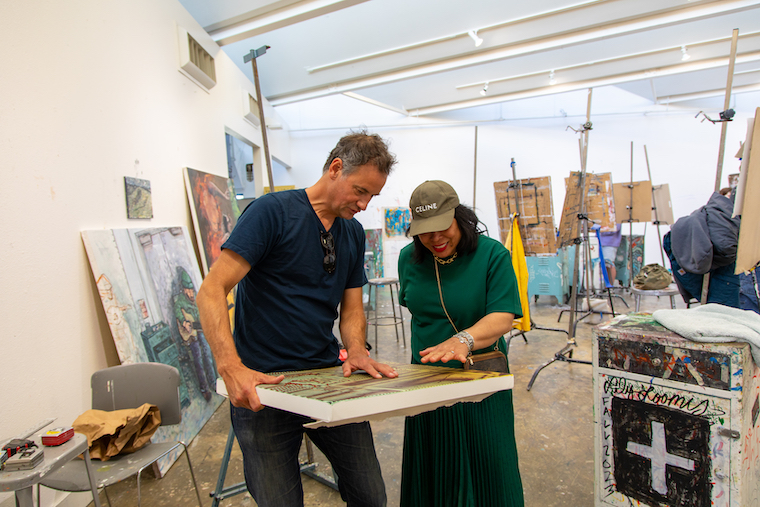Recently, the University of California, Santa Cruz Arts Division hosted a workshop with alumnus and noted artist Fritz Chesnut. For three days Chesnut worked with a group of Art students teaching them a technique for applying paint distinctively to canvas using unexpected tools and materials as a new mode of creating abstract art.
Chesnut, a member of the Arts Dean’s Advisory Council and a supporter of student scholarships, was invited to campus by Dean of the Arts Division, Celine Parreñas Shimizu; similarly the students in attendance were nominated by various professors to join the workshop. After graduating in 1995 from the Art Department, Chesnut went on to secure his M.F.A. from Rutgers University and exhibit his work across the country, predominantly in California and New York.
“Fritz generously serves as an inspiring mentor for our students and our recent alumni. He empowers them with the audacity to believe in their work and nurture their craft. We are so grateful for his time and his wisdom, his generosity and guidance,” say Dean Celine (as she is affectionately referred to by the students). “As one of our Arts Advocacy Council members, he also gives his support to amplify our shared goals, aspirations and ambitions. He understands the importance of sharing first-hand experiences and offers our students valuable lessons and insights into what it takes to develop one’s voice and navigate the art world as an artist.”
One of Chesnut’s favorite parts of teaching was coming to Santa Cruz to surf and see his son, who is a frosh in Porter College. “It's this mixture of something old and something new,” he says. “I’m coming and meeting all these new people but also this is where I went to school and I’m seeing how it's totally different.” Chesnut fondly remembers working in the studio he now gets to teach in.
Chesnut’s workshop focused on a new way to put paint to canvas. “It's just another kind of tool to have in our toolbox,” he says. This technique involves painting onto plastic sheets, often using a squeegee to create lines and patterns, waiting for it to dry, then removing said painting and adding it to a canvas. Chesnut started using this technique around two years ago as a way for him to make larger pieces and incorporate more layering. The effect is both industrial and environmental simultaneously.
“I was really excited that I got offered this workshop, this school has so many opportunities I’ve missed and I didn’t want to miss this one,” says art student Maggie Dougherty. “It’s exciting to meet alumni who’ve really succeeded in the same work I'm hoping to succeed in.” Other students expressed similar sentiments about getting to meet Chesnut and learn from him.
Students also considered ways to bring this new technique into their own work. “I really love how these abstract lines he makes with the squeegees look like deteriorated material, and I feel like it's the direction I want to take my art,” says student Jaden Anderson, who likes to focus on deterioration in architecture. “Being able to manipulate the paint once it's dry enough to touch is a whole new world.” Other students expressed interest in this new process for reasons ranging from they are already focused on abstract art, to they’ve never done abstract work before.
Chesnut’s lessons helped students get out of their comfort zones and let the process lead them. Many of the students expressed a history of creating art by fully conceptualizing the piece before they even begin, but Chesnut’s lessons forced them to constantly rethink what they were doing throughout the process. “It echoes something I’ve been thinking about with art: letting the medium lead you, instead of having these concrete ideas in your head before you start the work,” says Nico Lown Heitz. “It’s about having the room for error and accepting that as a stepping off point.”
Most of the workshop was spent on students working on their pieces. Chesnut wandered around the room chatting with and assisting students one by one. “My favorite part is talking to the students,” says Chesnut. Students felt similarly about him. Though Chesnut’s workshop is now over, he says the only thing it would take to bring him back is another invitation from Dean Celine.
Dean Celine is still reeling with inspiration from Chesnut’s visit, especially the lecture and slide show he shared with students, staff and faculty after the three-day workshop. Chesnut showed key examples from the body of his work spanning from his undergraduate days at UC Santa Cruz to his M.F.A. training at Rutgers and beyond. He spoke fondly of the encouragement he received from faculty member Professor Beth Stephens who recommended him to pursue graduate school and they still remain in contact. “It was astounding to see the strength of Fritz’s work from the very beginning,” says Dean Celine. “In his earlier work as an undergraduate, he commented on the self-presentation skills necessary to market one’s own work as an artist. In his graduate work, he captures in his work the ecstasy on viewers’ faces and bodily comportments when they’re seeking and experiencing art, television and even celebrity. These views are brilliantly expressed in his paintings which focus on people in the audience’s spaces of TV talk shows, museums and red carpet events. Even more moving is his openness in sharing his own processes and methods, and his desire to help the next generation of Banana Slugs. We will have him come back!”



